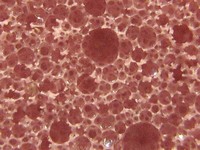Visco Elastic Foams (continued)Because of these characteristics, visco elastic foams provide several advantages over traditional FPF when it comes to both safety and comfort in seat cushions. With their ability to damp impact loads, visco elastic foams can allow seats to reduce the effective impact experienced by occupants. Also, their rate responsiveness, and heat responsiveness allow them to distribute the weight of the occupant, and reduce blood flow restrictions which are the major source of seating discomfort.There are a number of manufactures that now produce this type of foam for the bedding industry, however foams intended for bedding are not well suited for most seating applications because the IFD rating is relatively low. Confor and Sunmate are two of the more common brands of visco-elastic foams that are intended for a wider variety of applications. They both have foams that are suitable for use in aircraft. Confor foam is probably the most prevalent in aircraft applications, and is produced by a company called EAR Specialty Composites.  | | Semi open cell structure of Confor foam from EAR Specialty Composites |
Visco elastic foams offer several advantages over other types, but these benefits do come with some trade-offs. Because of their higher densities these foams are more expensive to manufacture. These higher densities also lead to heaver finished products. In most cases this results in parts that are up to 3 times heavier than equivalent FPF parts. In addition the durability of these foams is considerably less than comparable FPF. On the other hand, visco elastic foams offer features that you just can’t get from FPF.Wrap UpIn this article we discussed how foam is made, how it is defined, how it is formed and fabricated, and some information about two different types of foam. Hopefully some of the information presented was useful, and added to your knowledge of aircraft seating foams. | | Pages
[ << ]
[ 1 ]
[ 2 ]
[ 3 ]
[ 4 ]
[ 5 ]
[ 6 ] |
|